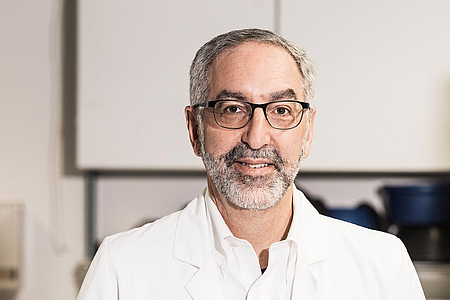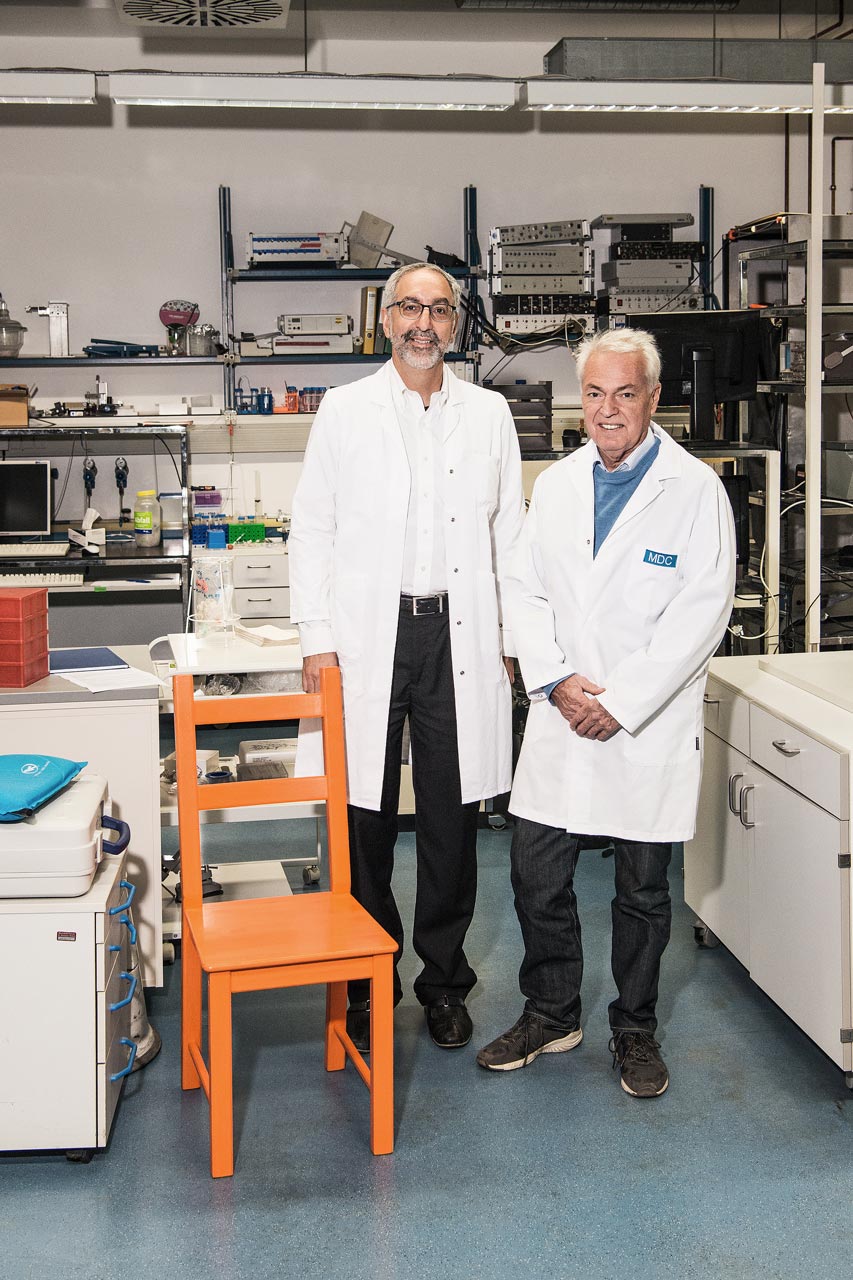Transatlantic research on the control units of the brain
When an American physician from the field of patient-directed translational research and a German basic researcher meet, that encounter can take them in many possible directions. In the case of Professor David Gutmann and Professor Helmut Kettenmann, it led to a merging of their respective research teams. In an interview, they told us what conditions are essential for successful transatlantic collaboration and what can result from it.
Professor Gutmann, this is third time that you’re in Berlin for a longer period as an Einstein BIH Visiting Fellow. What impression has the city made on you?
Gutmann: After each stay in Berlin, I always find it difficult to leave for home. There’s so much to do here. Berlin has got a lot right, from accessible public transport to the wide range of culinary and cultural offerings. From where we live in Mitte, we can simply open the door and dive straight into the vibrant life of the city, with its countless cafés, music venues, museums and galleries.
How did you both hit on the idea of initiating a project together?
Gutmann: Professor Kettenmann is one of the pioneers in research on glial cells, a type of brain cell with a supportive function. I had followed his work for many years, but we only met personally for the first time at a symposium on brain tumors at the Max Delbrück Center for Molecular Medicine. For 25 years, my research team has been working to define the molecular mechanisms that underlie a disease that causes nervous system deficits: Neurofibromatosis Type 1 – NF1. We discovered that a subcategory of glial cells called microglia influences the way in which diseases of the brain develop in patients with NF1, specifically brain tumors that arise in children. While we have made numerous advances, I was looking to expand this work. The funding from Stiftung Charité offered me the opportunity to come to a place that’s known all over the world for its groundbreaking research on glial cells. Together, we’re now studying how NF1 mutation alters the biology of the human and mouse microglia relevant to normal brain function.
Kettenmann: Also, as a biologist I haven’t had any formal medical training, whereas David actively cares for patients with NF1. This makes the collaboration all the more exciting on both sides.
So how much time do you still spend in the clinic?
Gutmann: I typically spend 75 per cent of my time in the lab. However, my patients are the main motivation behind my research. The most interesting questions arise when I’m caring for children with NF1. However, these problems can only be addressed through basic laboratory research.
Kettenmann: One of our techniques for producing microglia uses what are called induced pluripotent stem cells.

Funding program
Einstein BIH Visiting Fellows
Funding period
2017 – 2020
Project title
Biology and treatment strategies of low-grade gliomas
Research area
Cell biology
Institution
Max Delbrück Center for Molecular Medicine (MDC)
2017
Humboldt Research Award of the Alexander von Humboldt Foundation
Since 2015
Vice Chair for Research, Department of Neurology, Washington University School of Medicine, St. Louis, MO, USA
Since 2001
Professor, Departments of Neurology, Pediatrics, and Genetics, Washington University School of Medicine, St. Louis, MO, USA
To this end, Dr. Gutmann collected skin and urine samples from patients and reprogrammed the cells to turn them into stem cells. They then regain the ability to develop into all possible cell types – into microglia in our case. This is the only way to obtain human material. We want to use this technique to compare normal and NF1-mutant cells. Every individual with NF1 was born with a mutation in one copy of the NF1 gene.
What was the reason for conducting the project in Berlin rather than in the USA?
Kettenmann: The funding possibilities over here are unique. The project was made possible by Stiftung Charité, using the funds of Johanna Quandt. There’s no comparable scheme in the USA for attracting foreign scientists to come for lengthy research stays. Even in Europe, this seems to me to be something unique.
How is the work specifically divided among you in your project?
Kettenmann: It’s interesting for the students to be supervised simultaneously by two researchers with completely different backgrounds: one coming from basic research in Germany, and the other from clinical research in the USA. Professor Gutmann perfectly implements the idea behind the Einstein BIH Visiting Fellows. He’s now on his third two-month stay here and always has a sympathetic ear for students’ concerns.Gutmann: If I’m not physically present, we have team meetings via Skype. This allows our research teams to interact. In addition, they regularly exchange experiment protocols.
We’re good at producing induced pluripotent stem cells. At the same time, we’ve learned many things about the analysis of microglia from Professor Kettenmann’s research team. This exchange enriches our research enormously. The laboratory here is very welcoming, and Professor Kettenmann is a great host.
Do you think that this may motivate your students to consider an international career themselves?
Gutmann: The Einstein fellowship has already provided unprecedented opportunities for international collaboration and training. As an example, one postdoctoral researcher who trained in the Kettenmann Lab has joined us as a postdoctoral research fellow. That’s the first successful transatlantic transplant we’ve achieved (laughs).
When you look back at your time as a doctoral student, how has research changed in this field?
Gutmann: As a doctoral student, I had the feeling of being restricted by the abilities and techniques of the lab where I trained. Everything demanded great effort: sequencing was a full-time job. I think that today, young people in research are less tied to what their supervisors can do well or what’s available in the respective laboratory. Core Facilities allow technological obstacles to be overcome and more questions to be answered. In our lab in the 1990s, a postdoctoral researcher worked for eighteen months to create our first genetically modified mouse. A Core Facility can achieve that in three to four months. This means that young scientists can really get to see the big picture.
Are there any moments when you achieve results in a completely unexpected way?
Gutmann: I’d be disappointed if my data would only ever confirm my expectations. That wouldn’t be real science. Being confronted with unexpected results often means being able to explore and pursue an interesting new direction. Each time you reject a hypothesis, there‘s a new hypothesis waiting for you.
Kettenmann: For example, we were very surprised to find that there are big differences between the microglial cells of male and female individuals, both in mouse and human models.
What does that mean for patients?
Gutmann: This discovery will help to usher in a new era of improved risk assessment in the clinic. As we deepen our understanding of the factors that confer disease risk, the ability to deliver more personalized medical information will emerge.
Do you feel that the general public are well informed about neurological diseases?
Gutmann: In the USA, but also in other countries, there is sometimes public mistrust of scientists. To become more transparent and to share our exciting research with people, we need to open our doors. This is critically important, as tax payers are funding the majority of laboratory research. If they don’t trust us, research funding will be the first thing to be cut. We simply can’t afford to let that happen. In our NF Center in St. Louis, we strive to involve our families through newsletters, laboratory tours, and in-clinic discussions. Understanding what we do in the laboratory provides hope for families for whom few effective therapies currently exist.
Kettenmann: There are some initiatives aimed at making research more accessible. The Life Science Learning Lab at the MDC, where new scientific discoveries are presented for school groups, is permanently booked up. Many years ago, Detlev Ganten initiated the Long Night of Science. In addition, with the support of the Hertie Foundation, we founded the website dasgehirn.info, which explains the brain using very clear images.
How well-known are the functions of the glial cells?
Kettenmann: In the 40+ years that I’ve been working in this field, we‘ve already achieved quite a lot. However, when I look at how many people are researching neurons, we’re still a small community – despite the fact that half of all the cells in the brain are glial cells. Nevertheless, today every neuroscientist is well aware that we’ll never understand the brain without comprehending all the cell populations that control and steer the brain.
October 2018 / MM
